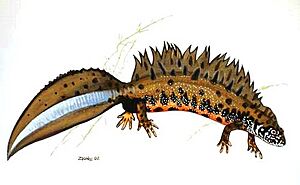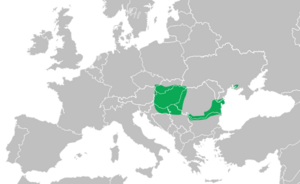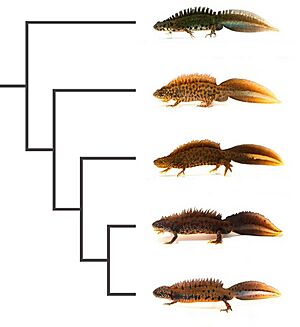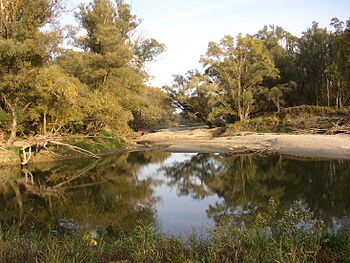Danube crested newt facts for kids
Quick facts for kids Danube crested newt |
|
|---|---|
 |
|
| Conservation status | |
| Scientific classification | |
| Genus: |
Triturus
|
| Species: |
dobrogicus
|
 |
|
| Synonyms | |
|
|
The Danube crested newt (Triturus dobrogicus) is a type of newt found in central and eastern Europe. It lives mostly around the Danube river and some other rivers like the Dnieper. This newt is smaller and thinner than other newts in its group, called Triturus.
Like other crested newts, the males grow a cool, jagged crest on their back and tail during their breeding season. For more than half the year, these newts live in slow-moving water, like river edges, lakes, or ponds. This is where they have their babies.
Males do a special courtship display to attract females. Females lay about 200 eggs, one by one, on water plant leaves. The baby newts (larvae) grow in the water for two to four months before they change into adults (this is called metamorphosis). For the rest of the year, the newts live on land in shady places, usually forests.
Even though they are not yet considered in danger, the number of Danube crested newts has gone down a lot. This is mainly because their homes (habitats) are being destroyed. This newt species is protected by law in the European Union.
Contents
How Scientists Classify the Danube Crested Newt
The Danube crested newt was first described in 1903. At first, scientists thought it was just a type of northern crested newt (Triturus cristatus). Later, they thought it was a subspecies (a group within a species).
But then, scientists used genetic analysis to study its DNA. This showed that it is actually its own separate species. The northern crested newt is its closest relative.
In 2000, scientists thought there were two different types (subspecies) of Danube crested newts. One lived in the Danube Delta and the other in the Pannonian Basin. However, newer genetic studies did not find enough differences to keep them as separate subspecies.
What the Danube Crested Newt Looks Like
The Danube crested newt is the smallest of the crested newt species. It usually measures about 13 to 15 centimetres (5.1 to 5.9 in) long. Females can sometimes grow up to 18 centimetres (7.1 in).
It has a thin, long body that is great for swimming. Its head is narrow, and its legs are quite short. This body shape helps it move easily in the water. It has more vertebrae (bones in its spine) than other crested newts.
The back and sides of the Danube crested newt are dark brown with black spots. It also has tiny white dots. Its belly is orange to red, which is different from other crested newts that usually have yellow bellies. The belly has black blotches with sharp edges.
During breeding season, male Danube crested newts grow a tall, jagged crest on their back and tail. This crest usually starts between their eyes and nostrils. It stops at the base of their tail. Males also get a cool bluish-white stripe along their tail during this time. Sometimes, females have a yellow stripe along their back.
Where the Danube Crested Newt Lives and Its Home
The Danube crested newt lives in three separate areas in central and eastern Europe:
- Pannonian Basin: This area stretches from eastern Austria through Slovakia, Hungary, and parts of other countries like Croatia and Serbia. It includes the middle parts of the Danube river and some of its smaller rivers.
- Lower Danube and Danube Delta: This part is separate from the Pannonian Basin. It covers southern Romania, northern Bulgaria, and parts of southern Moldova and Ukraine.
- Dnieper Delta: This is a small area in southern Ukraine. Scientists think this area was once connected to the Danube basin by marshlands a long time ago.
The Danube crested newt's home also borders where other crested newts live. For example, the Italian crested newt lives to its west.
Compared to other crested newts, the Danube crested newt is better at living near rivers. It often lives in flowing water, even with fish around. They like to breed in slow-moving river edges, oxbow lakes (U-shaped lakes), flooded marshland, or large ponds. These places need to have lots of plants underwater. When they are on land, they live in forests, bushy areas, or meadows.
Life Cycle and Behavior of the Danube Crested Newt
Danube crested newts spend more time in the water than other newts in their group. Adults usually move to their breeding spots in February or March. They often stay in the water for about six months. Sometimes, they might even stay longer or go back into the water in the autumn.
Males do a special dance to attract females. If a female is interested, the male will lead her over a small packet of sperm (called a spermatophore) that he puts on the ground. The female then picks it up to fertilize her eggs inside her body.
A female lays about 200 eggs during the breeding season. She carefully folds each egg into the leaves of water plants. The eggs and baby newts (larvae) are smaller than those of other crested newts. They also take longer to grow, usually two to four months, before they change into adults and leave the water.
Both in water and on land, these newts are mostly active at night. In the water, they hide under plants. On land, they use things like logs, rocks, or small animal burrows to hide. They mainly eat different small invertebrates (animals without backbones). In the water, they might also eat tadpoles or smaller newts. Some animals that hunt them include herons, snakes (like the grass snake), and various mammals.
Threats and How We Protect Them
The number of Danube crested newts has gone down a lot. The International Union for Conservation of Nature says they are of "least concern" right now, but their population is still shrinking. The biggest danger to them is when humans destroy their homes. This happens when land is drained, dams are built, or water gets polluted.
Sometimes, they also mix with other crested newt species, which can cause problems. Losing breeding ponds because of less rain in their southern areas (possibly due to global warming) is also a threat.
Like other crested newts, the Danube crested newt is protected by important laws. These laws make it illegal to catch, bother, kill, or trade them. It is also against the law to destroy their homes.
See also
- List of amphibians of Europe




